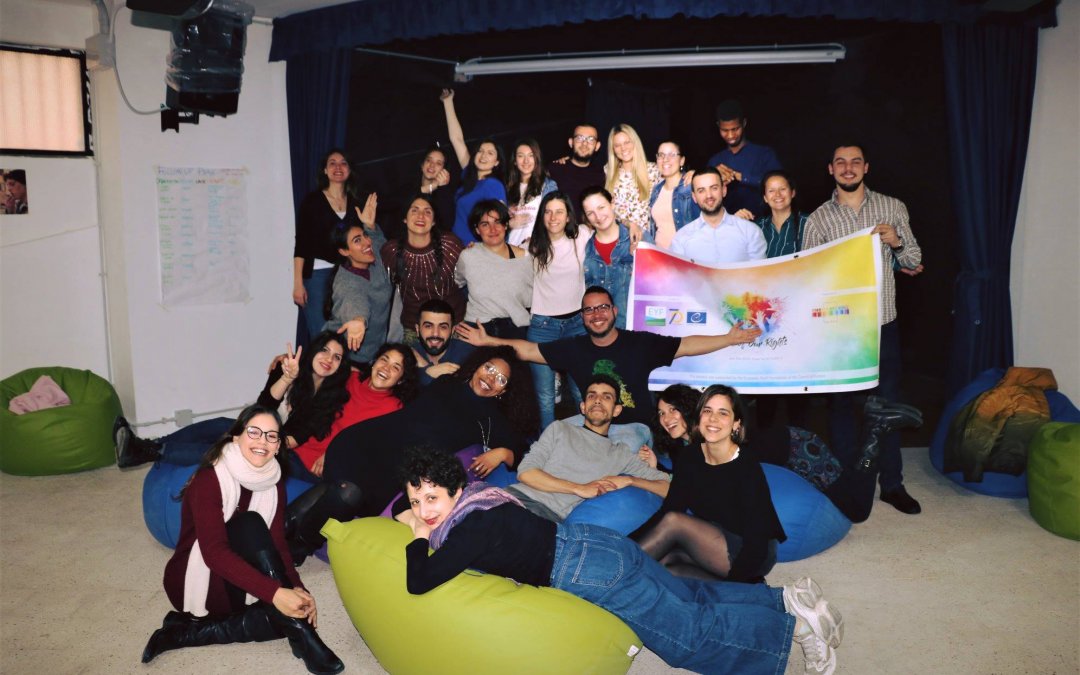The training course “My Art and Your Rights” was held in Palermo from 17th to 23rd March, as the first activity of the Workplan “Art of our rights” funded by the European Youth Foundation of the Council of Europe.
The training involved 20 young artists from different countries – Albania, Germany, Spain, Portugal, Armenia, Turkey, Montenegro, Serbia, Greece and Italy – with the aim of sharing the different experiences on the use of art as a tool of promoting human rights and supporting the learning of non-formal education techniques and methodologies.
The participants, from the very beginning, got in touch with the world of non-formal education – unknown to many – through knowing-each-other activities, team building and group dynamic, all enriched by the variety of tools offered by art: theatre tools, use of plasticine, painting and drawing techniques, led the young artists in a path of knowledge of the group but at the same time becoming aware of the fears and expectations, linked to their involvement in the project, which will see them engaged for a period of one year.
It’s Mission Impossible time! The participants were in fact involved in a “hunt for artistic treasures, offered by the city of Palermo – rich in heritage from different eras and cultures – and this allowed the group to learn more about the place that would host them for a week and at the same time approaching further ways in which art, over the centuries, has represented an important instrument of denunciation and testimony.
The second day, instead, was dedicated to the essential theoretical aspects to understand the context within which the project is in, and their role as young artists and spokesman of the value of human rights.
Through videos, debates and interactive activities, the group had the opportunity to get to know the Council of Europe – and the importance of its activities in the defense of human rights and the opportunities it offers, such as the EYF – but also to be able to address the issue of human rights, starting first of all from the definition of them; on this occasion, the whole group showed a strong interest and involvement: it was important to give space and voice to their opinions and experiences to be able to understand what is the current perception of human rights, and how it is anchored to cultural and traditional aspects .
But how do Education, Human Rights and Art link together? What better way to make them understand the correlation, if not through examples?
In fact, examples and results of previous project activities were shown to the group, in which art, in all its forms, represented an instrument of inclusion and promotion of human rights; in particular, the young artists discovered the initiatives All in, Arte Migrante, Artoolkit among others.
And in other countries? How is art used in the field of human rights?
“My city, my city” was the moment in which our participants were able to share experiences and examples from their respective countries with the rest of the group.
Emotion, anger, frustration, dismay: the projections and stories of each one brought to light the sad reality in which we live today and of which we are often not aware.
Defending and promoting human rights requires commitment first and foremost! A commitment that, in the face of the violations we see every day, can find support in the education of individuals and communities.
During the third day, in fact, the group had the opportunity to better understand what non-formal education is and what is meant by facilitation, and how, in synergy with art, they represent important tools for being able to work with young people; but to support an educational path, means first of all to understand the learning approaches and the needs of the people, and to set oneself the objectives that we want to reach through our activity: the third day ended by addressing the theme of learning styles and which are the steps and the fundamental aspects to give life to a project.
The best way to learn is through experience: with the fourth day the “HUMANS OF PALERMO” is launched. The group, in fact, had a day to work in small groups, and develop a small project, starting from the needs found in the city of Palermo.
The hard work has brought wonderful results that were presented during the last day, inside the Cine-Teatro Tascabile, at the operational headquarters of CEIPES.
It is time to say goodbye…for now! and our young artists are ready to get to the heart of the second activity of the Workplan: thanks to the support of the youth workers of their sending organizations, each national group will design and implement a project within their own community, using art as a tool for promoting human rights and raise awareness on them.
The path experienced during the training allowed each participant to acquire new knowledges and methodologies, but at the same time to become aware of what, despite centuries and centuries of struggle, the road of human rights is still long and, as long as there will be a corner of the world in which we cannot talk about RIGHTS and HUMANITY, we are all called to intervene, even if through a brush or a guitar.
